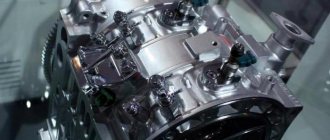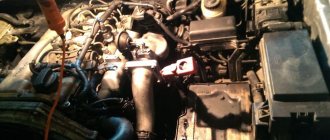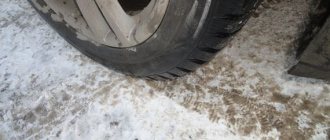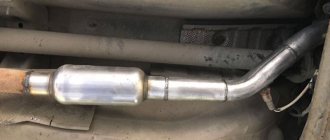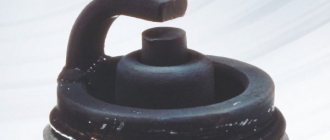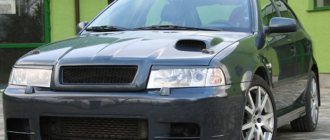Friends, if among you there are drivers with extensive experience, then they know perfectly well what to expect from a car and what unpleasant surprises it can present on the road. In this article we will learn how the ASR traction control system and its brothers work, why this technology is needed and what its secret is.
What should people who have just started driving do? For them and, of course, not only for them, active safety technologies have been developed to help prevent emergency situations, including a system that eliminates slipping.
//www.youtube.com/watch?v=iBU2n-HI2oM
There are many names, but the essence is one
Just like the ESP system, about which there is already an article on our blog, the traction control system has many names, although the essence and principles of its operation practically do not change depending on what words it is called. In order not to be unfounded, we will give a number of examples of how different automakers call the same technology.
So, for example, on Toyotas it is called TRC (Traking Control), on Mercedes, Audis and Volkswagens it is the ASR (Automatic Slip Regulation) system, those who drive a Honda know it as TCS (Traction Control System), and on BMWs - This is ASC (Anti-Slip Control). And this is still an incomplete list of traction control system names.
We hope that we have understood the nuance of terminology, and now you will not have questions like: “What is the TCS system?” Let's move on.
What is ESP in a car?
Electronic Stability Program, or ESP, is an electronic stability control system, also called stability control. The main purpose of ESP is to control the torque of the wheels, which allows you to eliminate lateral movement and level the position of the car.
Like ASR, the system has several analogs that are used in specific brands of cars:
- ESC is installed on KIA, Hyundai and Honda cars.
- Rover, BMW and Jaguar are equipped with DSC.
- A distinctive feature of Volvo is the DTSC system.
- You can find VSA in Acura cars.
- Toyota models are equipped with VSC.
- Subaru, Nissan and Infiniti cars use the VDC system.
Secrets of non-slip wheels
It's time to understand how the traction control system works. For example, let’s take ASR technology, although, as we have already said, it is not fundamentally different from its analogues. Technically, it is built on the basis of anti-lock ABS - it uses the same wheel speed sensors, some of its actuators and even a common control unit. However, the operating principle of ASR is such that it cannot be limited to just the braking system.
ASR system diagram
Let's get acquainted with the algorithm for the functioning of the traction control system. First of all, she needs to determine a number of parameters:
- wheel rotation speed;
- vehicle speed;
- degree of wheel slip;
- the trajectory of the car.
If it suddenly turns out that one of the parameters has a dangerous value, the electronics sends signals to the actuators. In the case when the car speed does not exceed 80 km/h, as a rule, slipping is eliminated by braking the wheels. If the speed is above 80 km/h, ASR begins to control engine operation, reducing torque.
The ASR system and the nuances of its operation
ASR helps prevent loss of traction in a vehicle's wheels by using an electro-hydraulic system that controls the engine and brakes in adverse road conditions or if the driver uses excessive acceleration and the wheels begin to slip on the pavement. The ASR system helps the driver avoid making mistakes in adverse road conditions and helps the driver maintain control of the vehicle.
Professional drivers complain that ASR affects vehicle performance, but this standard equipment in high-performance vehicles helps beginners and drivers who often overestimate their ability to control the vehicle in adverse weather conditions, and restores driver control in unexpected circumstances.
ASR technology has been in most cars and motorcycles since about 1992. And it dates back to the early 1930s, when Porsche developed a limited-slip differential, which allows one wheel to spin slightly faster than the other to improve traction. The ASR system is closely related to ABS. The first users of ASR, which was already complemented by an ABS system, were BMW in 1979.
How the ASR system works
Main functions and purposes of PBS
The ASR system is built on the ABS anti-lock braking system. The functions implemented in ASR are differential locking and torque control.
Only for experienced drivers
There is an opinion that traction control technology does not always please experienced drivers who like to independently control the car in all situations. In addition, it generally interferes with fans of extreme driving - you won’t burn the tires, you won’t be able to take turns effectively, so the question often arises: “How to disable ASR?”
In fact, there is nothing simpler - there is a special button that temporarily deactivates the traction control system, and a warning light on the instrument panel will remind you that it is turned off.
In conclusion, I would like to say that you should not neglect the electronics in your car, no matter how experienced a driver you are.
Be careful on the roads!
And, of course, don’t forget to subscribe to the blog, in whose articles you will reveal all the secrets of your cars. Tags security
Negative points
Often on some forums you can find entire “threads” that fight and disable traction control systems in different ways. But why? After all, how did we figure it out from above whether there are only advantages or not? Are there any downsides? Of course, there is nowhere without them:
- Worsens the dynamics. And significantly. If someone tried to “take off” sharply on a snowy road with anti-skid, he noticed that the engine was roaring at high speeds, but the car was not moving! Everything is simple, the system slows down the wheels that are slipping, there is no drift to the sides, but there is no dynamics either. Moreover, this can also work in the summer, when you start with axleboxes. So if you want to “fight” with someone on dry asphalt, turn off this setting.
- Inadequate performance. This was observed in some cars, for example, in LADA X-RAY cars from the first years of production, with the ATIBUX turned on, even with small obstacles, the car stood up helplessly and could not leave. It was simply an inadequate setup, electronics that were not brought to perfection. Moreover, it was impossible to turn it off. The principle was this: the slipping wheel was choked, but the normal torque was not transferred to the other one, which was in gear. In the latest versions, this has all been corrected, and a key has appeared that disables this system.
In general, these are probably all the disadvantages; I think there are many more advantages.
Purpose of the unit
As noted above, the most important function of the traction control system is to ensure the safety of the driver and the vehicle and maintain control during acceleration. However, it can also influence other operational and technical factors. Thus, there is a significant unloading of the active elements of the transmission (primarily the clutch), a decrease in fuel consumption, and a decrease in tire wear.
Another aspect that cannot be ignored is the psychological state of the driver. Experts have repeatedly noted that the use of electronic security systems and, in particular, traction control reduces fatigue and irritability and allows you to concentrate on driving the vehicle.
The ASR system, or TCS, has come into use quite recently. Before it, the main functions of ensuring active safety were taken over by ABS, which for several decades has been a mandatory element of any foreign car, regardless of its class and price category.
The disadvantage of ABS is its limited functions and the presence of a large number of mechanical components. Thus, the principle of operation is so banal that it does not feel the difference between ice and sand, does not control the braking axes separately, but works with them synchronously.
Soon after the introduction of ABS into large industry, it became clear that it was impossible to function alone.
So what is the operating principle of a modern car traction control system? What is TCS based on and why can it be useful to the driver?
Experienced motorists know perfectly well why a traction control system is needed. However, most beginners who are just starting their driving career have little idea of the purpose of such complex and expensive electronics.
In order to clearly imagine why and for what purpose the traction control system is used, you need to imagine how the car goes into a skid at the next sharp turn. If you do not calculate the speed and make the maneuver too quickly, then a skid will be quite likely and will not take long to occur.
In addition, for front-wheel drive cars, recovery from a skid is quite difficult, which without installing TCS will make it almost uncontrollable, except when a professional racer is behind the wheel.
TCS is designed to control the torque supplied to each wheel individually and control the torque that the engine delivers to the drive axle. In this regard, the electronics equipped with the traction control system are capable of correcting the course of a car that has already entered a skid, and almost instantly stops it without driver intervention.
Any traction control system described above can provide the driver and passengers with greater safety. In addition, a car in which such a device is installed increases the life cycle of tires, increases engine life and fuel economy, and also makes the car more manageable.
It is worth noting that, if desired or necessary, the system can be temporarily “disarmed”. To do everything right, you need to know how to turn it off safely. In most cars, disabling the traction control device allows the car to remain protected from unexpected wheel locking that may occur during braking. When a problem occurs in the system, the control unit completely blocks it, due to which the warning lights on the panel light up.
The traction control system has found wide application in world auto racing; Formula 1 racing cars have been equipped with it since 1990. The electronic system was first presented by the Ferrari team pilots. However, soon the management of the event banned its use. The ban on the use of anti-slip devices is explained by the fact that while driving, the brakes must be applied exclusively by the pilot, without resorting to additional equipment.
TRC (Traction Control) system
This security system is used mainly on expensive models of Honda and Toyota cars.
The operation of this system complements the others by preventing the car from skidding. The operating principle of this system involves reducing traction and torque to prevent dangerous situations. The operation of this system is noticeable when passing dangerous turns with slippery surfaces. Thanks to this system, a car with a driven front axle will not go off course even with a sharp release of gas in a turn. The TRC system is even installed on all-wheel drive vehicles, such as the Toyota RAV 4.
If this system works, the driver cannot influence the movement of the car by pressing the gas pedal, because the system blocks this action.
So, modern cars are stuffed with various electronic assistants and this, of course, has a positive effect on road situations, because thanks to such systems there are fewer accidents due to poor road grip, and drivers without experience driving in winter are not afraid of icy roads.
How does a car's traction control system work?
The ASR traction control system allows you to avoid slipping off-road.
We recommend: Power steering (power steering): description, functions, purpose, device, photo
The impact on the drive wheels occurs in two ways:
The ASR system acts on the braking system, but when the threshold speed is exceeded, the effect is transferred to the engine, reducing torque.
- When driving at a speed of up to 60 km/h (this is an “average” figure, it may differ on different cars), the slipping wheel is slowed down by the braking system. This happens due to the fact that the ACP system includes a brake fluid pump that creates the required pressure. The supply of fluid to the brake cylinders is controlled by valves actuated by solenoids.
- When the set threshold speed is exceeded, the ASR control unit acts on the engine, sending signals that reduce the engine torque. This happens due to changes in the throttle position, misfires, and changes in the quality of the mixture. In addition, if the car has an automatic transmission, the transmission stage is selected accordingly - a higher gear is engaged, due to which the traction characteristics of the engine become “weaker”.
The threshold speed value is calculated in such a way as to avoid severe overheating of the actuators - braking at high speeds leads to “burning” of the pads, warping of the brake discs, boiling of the fluid, etc.
Vehicle ASR system shutdown button
If desired, the driver can disable the traction control system - at least in order to practice driving on deserted road sections - after all, any mechanism tends to break down and safe driving skills will not be superfluous. There is an “ASR OFF” button on the instrument panel or near the gearshift lever - this is the ASR system switch. As a reminder to the driver, a warning light on the instrument panel lights up when the system is turned off. You can find out how to disable the traction control system of your car from the owner's manual - the procedure includes several steps and may differ on different models.
When the ASR traction control system is turned off, a light on the dashboard lights up, indicating that the system is turned off.
For example, in order to disable ASR on a VW Jetta, you need to:
- Turn on the ignition.
- Turn on the emergency lights.
- Press the gas pedal five times. The “slippery road” indicator should light up.
- Start the engine and turn off the emergency lights.
But the next time you start the ASR will automatically turn on again. Moreover, ASR allows you to take off from a standstill, avoiding slipping, on slippery roads.
Common causes of malfunction
The performance of the TCS traction control system directly depends on the serviceability of the ABS.
The most common causes of failure:
- malfunction of one of the wheel rotation sensors;
- clogging of the wheel (comb) rotation speed tracking zone;
- violation of the integrity of the cables connecting the sensors to the control unit;
- failure of the ABS unit solenoid valves;
- ABS unit pump malfunction;
- blown fuses serving the control unit;
- CAN bus problems.
Troubleshooting TCS begins with computer diagnostics. After identifying the faulty sensor, assembly or component, they begin to eliminate the specific fault.
After eliminating the malfunction, the error remains active on many vehicles. In order to remove the error, you need to perform a certain sequence of actions in dynamic mode (sea trials). This can be a car moving with successive turns and braking. For example, in a Mercedes Sprinter car, these are four consecutive left turns with braking.
If the periodic lighting of the indicator during acceleration or changing the driving mode indicates the normal operation of the traction control system, then its constant flashing indicates the occurrence of breakdowns and malfunctions. In this case, the system automatically turns off. The first thing to do in such a situation is to switch to an extremely careful driving style and contact a qualified specialist who will diagnose the electronics and mechanisms. The most common breakdowns of the traction control system include:
- Failures in the program code of the electronic unit.
- Mechanical wear of the pump and/or valves.
- Depressurization of pipelines and highways due to shocks, vibrations, and destruction of seals.
- Sensor failures or loss of communication with them.
- Malfunctions in the operation of controlled systems - braking and torque control mechanisms.
Read more: Is it worth installing LPG on a car: pros and cons, savings, loss of power
Often, the breakdown is not limited to the traction control system, but affects the ABS and other related electronics. Ways to eliminate breakdowns directly depend on their source - if the problem is in the software, special programmers are connected to the on-board networks, and if mechanical elements are faulty, they are repaired or replaced.
The traction control system is a convenient and useful means of ensuring traffic safety, which can positively influence the technical condition and operational characteristics of the vehicle, reducing driver fatigue. All this becomes possible thanks to the use of innovative design solutions, the original and reliable design of the system, its high durability and maintainability.

